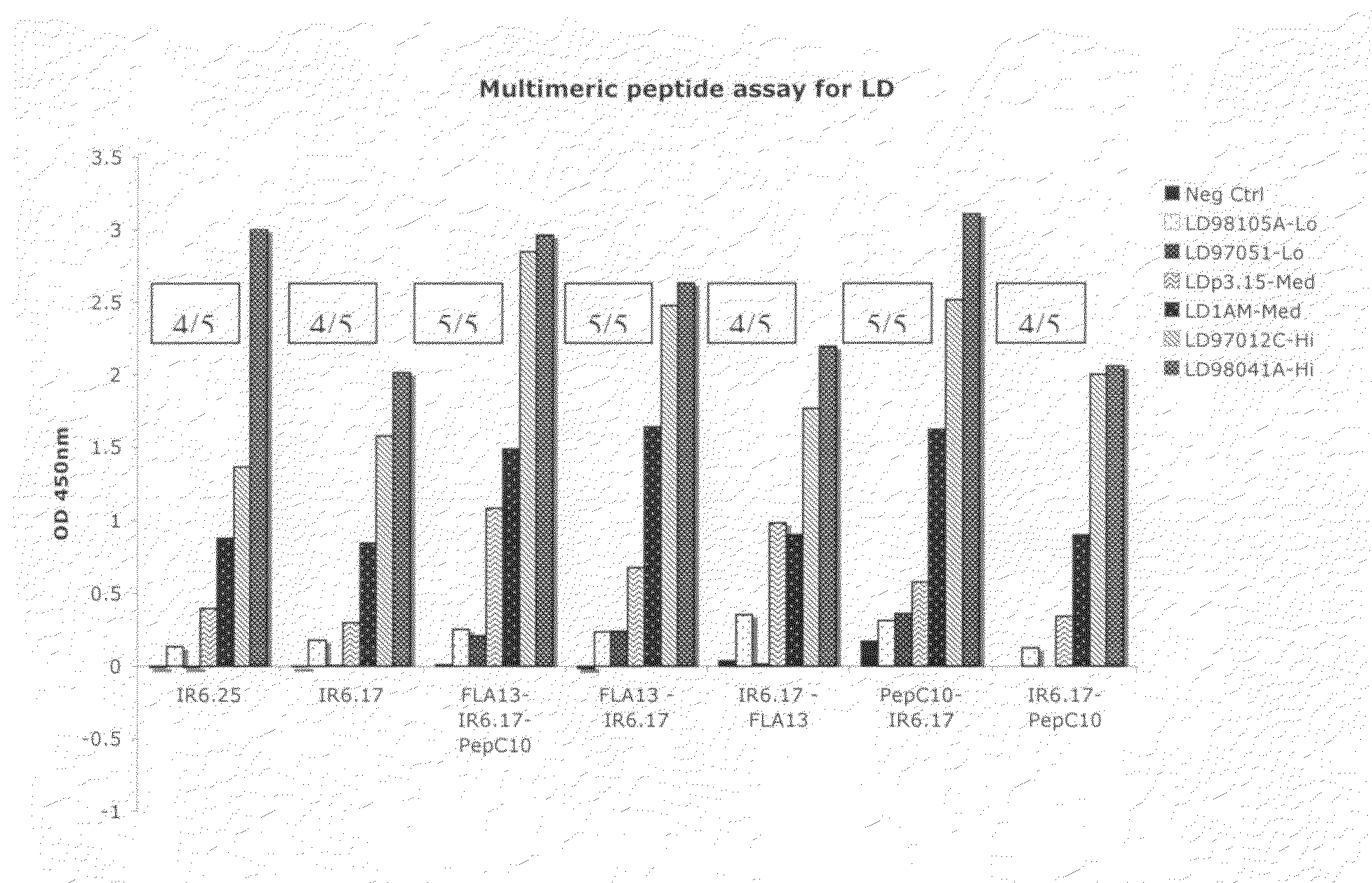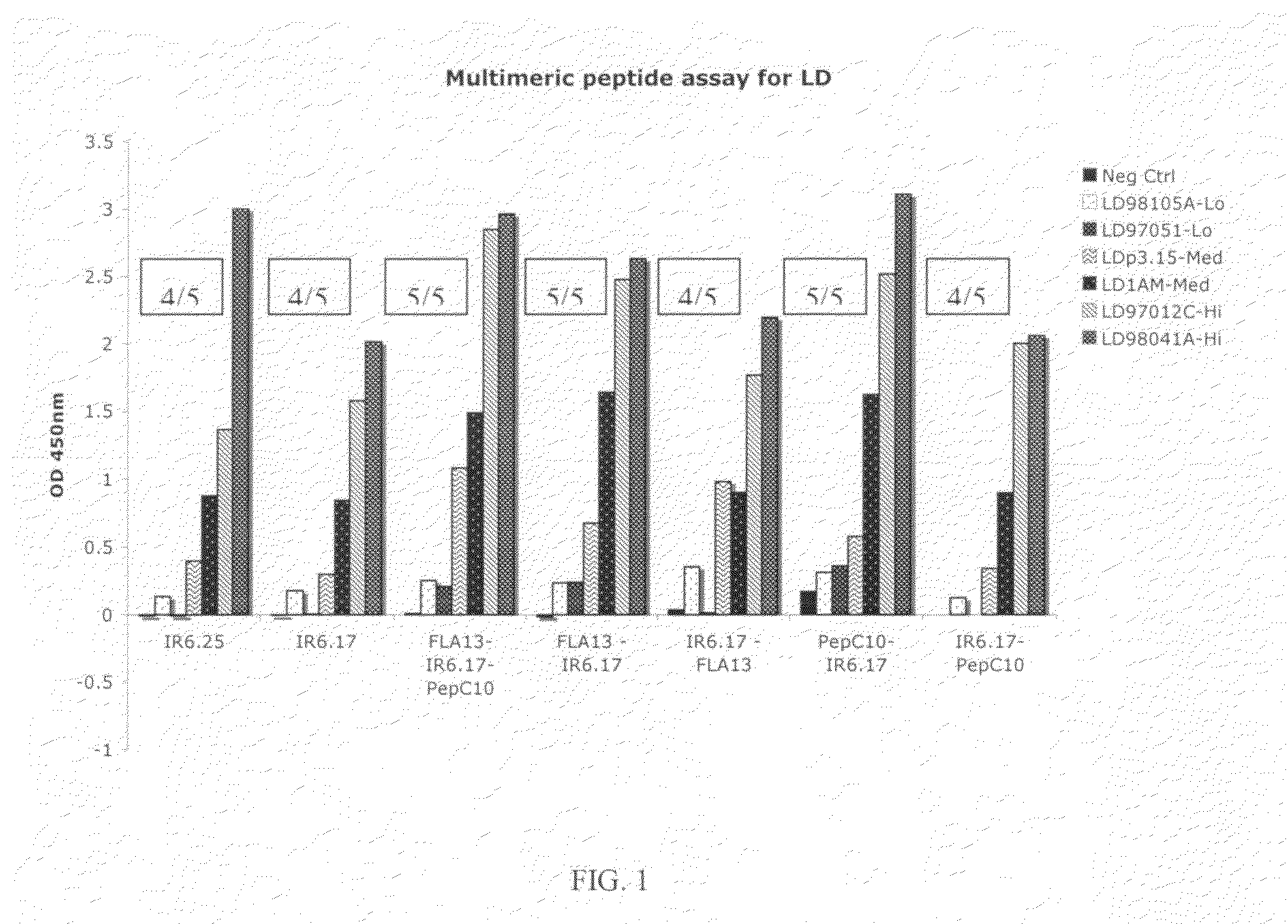Peptide diagnostic agent for lyme disease
a technology of lyme disease and diagnostic agent, applied in the field of lyme disease diagnostic agent and method, can solve the problems of low sensitivity and specificity of current serologic assays for such antibodies, difficult culture or observation of b. burgdorferi in clinical samples, and not all patients infected with pathogenic i>borrelia
- Summary
- Abstract
- Description
- Claims
- Application Information
AI Technical Summary
Problems solved by technology
Method used
Image
Examples
example i
Material and Methods
[0092]The following methods were used for the experiments in Examples II-VI and X-XI and will be used for the experiments in Examples VII-IX.
A. Peptide Synthesis:
[0093]Synthetic peptides are custom synthesized by the Keck Biopolymer Resource at Yale University, by automated solid phase methodology using FMOC N-protection protocols.
B. ELISA Procedure
[0094]Solutions of purified peptides (and control proteins) in 100 mM BIS-TRIS propane buffer (pH9.7) are used to coat commercial microwell plates (MaxiSorp®, Nunc) at 5 μg / ml. The coating procedure is as follows: 100 μl of a solution containing the appropriate concentration of antigen is added to each well and the microwell plate incubated either for 1 h at room temperature or overnight at 4° C. The antigen solution is removed from the wells; the plate washed three times with phosphate buffered saline, pH 9 (PBS); and 300 μl of a conventional blocking solution (e.g., 100 mM BIS-TRIS propane buffer pH9.7, 0.10% Tween ...
example ii
Comparison of 26-Mer Immunodominant Peptides from a Conserved Region of VIsE from Two Pathogenic Genospecies, B. Garinii and B. Burgdorferi Senso Stricto (Strain B31)
[0099]An approved first tier assay for the serodiagnosis of Lyme disease, referred to as the “C6 peptide assay,” is based on a conserved region of VIsE. The variable surface antigen of B. burgdorferi VIsE contains a 26 amino acid immunodominant region, IR6, that was reported to map as a single antigenic determinant in humans (see, e.g., Liang et al. (1999b) Infect. Immun. 67, 6702-06); U.S. Pat. No. 6,475,49; and Liang et al. (2000), supra). The sequence used to design the C6 peptide (PT7) was from a B. garinii strain, a strain not found in North America. A comparison of the amino acid differences between the IR6 sequences from B. garinii (PT7, strain IP90) and B. burgdorferi senso stricto (strain B31), a prototypic North American strain, is shown in Table 1. We synthesized the IR6 segments from both strains with N-term...
example iii
Defining a Minimal Epitope in the IR6 Region
[0100]In order to determine the minimum human active epitope(s) in this region and to maximize the coverage of the natural variation for diagnostic purposes, we employed a finely detailed mapping strategy, working from the natural sequence matrix, and used a human sera panel obtained from patients with culture confirmed acute Lyme disease presenting with erythema migrans. We shortened the 26-residue sequence of IR6 from the C-terminus until its efficiency in detecting Early Lyme disease antibodies dropped sharply after the deletion of the C-terminal eight residues. We then returned to the sequence of IR6 shortened by seven residues at the C-terminus and began deleting residues from the N-terminus. The results are shown in Table 2. Two of the peptides in Table 2 have, at their N-terminal ends, a C residue, which was appended, e.g., to facilitate biotinylation of the peptide.
TABLE 2Minimal Immunodominant Region in VlsE IR6 in B. burgdorferi ...
PUM
| Property | Measurement | Unit |
|---|---|---|
| temperature | aaaaa | aaaaa |
| pH | aaaaa | aaaaa |
| concentration | aaaaa | aaaaa |
Abstract
Description
Claims
Application Information
 Login to View More
Login to View More - R&D
- Intellectual Property
- Life Sciences
- Materials
- Tech Scout
- Unparalleled Data Quality
- Higher Quality Content
- 60% Fewer Hallucinations
Browse by: Latest US Patents, China's latest patents, Technical Efficacy Thesaurus, Application Domain, Technology Topic, Popular Technical Reports.
© 2025 PatSnap. All rights reserved.Legal|Privacy policy|Modern Slavery Act Transparency Statement|Sitemap|About US| Contact US: help@patsnap.com


